I set the alarm at 4:30 a.m. but I was just too tired so the next thing I knew, the caretaker of the guesthouse was knocking at my door at 5:15 a.m. Good thing I told him I planned to leave early. I took a jeep to the central terminal from outside the guesthouse, that was PHP7.50. At the terminal, there were FX taxicabs to various towns around Albay, Tiwi included. But after waiting for thirty minutes, still not much passengers and I was worried I would not make it in time for the 9 a.m. departure from Tiwi. So I heeded the advice of one of the dispatchers that I take a bus to Tabaco City where jeeps to Tiwi left regularly. Good thing I did since when I arrived in Tabaco, I was easily led to a jeep to Tiwi.
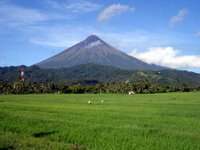 I made sure I sat on the left side of the bus as it offered the best views of Mayon Volcano. The mountain was nice to me today since there was not a single cloud in sight and I got to see about 180 degrees of it. The ordinary bus to Tabaco from Legazpi was just PHP20. While the jeep from Tabaco to Tiwi was PHP15.50. I arrived in Tiwi at about 8:30 a.m.
I made sure I sat on the left side of the bus as it offered the best views of Mayon Volcano. The mountain was nice to me today since there was not a single cloud in sight and I got to see about 180 degrees of it. The ordinary bus to Tabaco from Legazpi was just PHP20. While the jeep from Tabaco to Tiwi was PHP15.50. I arrived in Tiwi at about 8:30 a.m. The jeep actually goes as far as Tigaon. The cost of the jeep from Tiwi to Sagñay was PHP45 for the approximately one and a half hour ride that took us along a road in surprisingly good condition that zigzagged high up on cliffs that hugged the Pacific coastline of Bicol, offering breathtaking views of the black sand beaches and outlying emerald colored islands. It was a pity I couldn't tell the jeep to stop so that I could take photos.
 In Sagñay (pronounced Sangay), I went straight to the church. I was met by a CAT troop complete with a marching band practicing for a parade of sorts. Nice! The church was a little altered outside but still ok. When I got inside, I saw that an upcoming renovation was in the works as seen from the billboard. They plan to make the interior to look like that of the St. Peter's Basilica. We need to educate our priests and parish pastoral councils that Philippine religious art is unique, its elegance in its folksy simplicity.
In Sagñay (pronounced Sangay), I went straight to the church. I was met by a CAT troop complete with a marching band practicing for a parade of sorts. Nice! The church was a little altered outside but still ok. When I got inside, I saw that an upcoming renovation was in the works as seen from the billboard. They plan to make the interior to look like that of the St. Peter's Basilica. We need to educate our priests and parish pastoral councils that Philippine religious art is unique, its elegance in its folksy simplicity. From Sagñay, I took a quick motorbike ride to the next town Tigaon which was PHP15. Nice facade which I heard was funded by a family in the 1930s from money then won in the Sweepstakes. But again, when I got inside, another billboard announcing the need for P10.8 million! The church was also up for renovation.
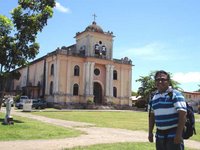 From the detailed plans, it showed they were going to replace the original clay tiles with granite. That component alone was a million pesos! I didn't see the need to change the flooring. It was an unnecessary and ostentatious expense that would make happy only the contractors and the priest whose whims and caprices were satisfied. Such money which priests extract from the townsfolk through all this fundraising hullabaloo could be used for the real pastoral mission of the Church which is definitely not construction.
From the detailed plans, it showed they were going to replace the original clay tiles with granite. That component alone was a million pesos! I didn't see the need to change the flooring. It was an unnecessary and ostentatious expense that would make happy only the contractors and the priest whose whims and caprices were satisfied. Such money which priests extract from the townsfolk through all this fundraising hullabaloo could be used for the real pastoral mission of the Church which is definitely not construction. I talked to the parish priest but you could see that his mind was set on wasting all that money for the renovations. And to think Tigaon is just a 4th class municipality. Such hypocrisy from the Church if they spend P10.8 million or even more for the renovations. You can contact the St. Clare of Assisi Parish in Tigaon, Camarines Sur at (054) 4523004. Tell the priests there what you think about their plan to spend millions for construction to emulate some church in First World Europe.
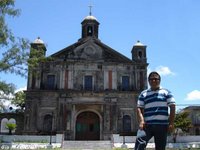 From Tigaon, I took a jeep to Goa which was PHP10. Goa had a large church with its courtyard dissected by a road which passed in front of the structure. The original gates and walls were still standing. But there was a permanent concrete structure in the middle of the patio (the one used for the salubong which had four posts each with balconies for angels and a hole at the top for the main angel to be lowered from) blocking the view from the main gate. I would later learn that this was a staple structure for churches in Camarines Sur. The sad part was that some were right smack in front of the church such as in Lagonoy, when they could have been put on the side.
From Tigaon, I took a jeep to Goa which was PHP10. Goa had a large church with its courtyard dissected by a road which passed in front of the structure. The original gates and walls were still standing. But there was a permanent concrete structure in the middle of the patio (the one used for the salubong which had four posts each with balconies for angels and a hole at the top for the main angel to be lowered from) blocking the view from the main gate. I would later learn that this was a staple structure for churches in Camarines Sur. The sad part was that some were right smack in front of the church such as in Lagonoy, when they could have been put on the side.  I had lunch in Goa and good thing there was an air-conditioned fastfood joint there. From Goa, I took a bus to Lagonoy. That was PHP8. Along the way, I saw the church in San Jose and decided I would stopover on the way back. As I mentioned, Lagonoy had a very charming church which was constructed amid a backdrop of mountains. The old gates and walls were still standing and it would have been a classic example of the lay-out of colonial churches had it not been for that concrete canopy they constructed right at the gates, in front of the church itself. Again, the inside was renovated! So it was off to San Jose.
I had lunch in Goa and good thing there was an air-conditioned fastfood joint there. From Goa, I took a bus to Lagonoy. That was PHP8. Along the way, I saw the church in San Jose and decided I would stopover on the way back. As I mentioned, Lagonoy had a very charming church which was constructed amid a backdrop of mountains. The old gates and walls were still standing and it would have been a classic example of the lay-out of colonial churches had it not been for that concrete canopy they constructed right at the gates, in front of the church itself. Again, the inside was renovated! So it was off to San Jose. Although it was not among the churches suggested to Gemma, I decided to stopover, attracted by the facade. Thus I was so surprised when I entered since it turned out to be the best-preserved of all the churches I visited in the past two days. Inside, I could easily distinguish the smell of age as I marveled at the well-preserved wall and ceiling murals (see photo below) the colors of which reminded so much of Tayabas. The San Jose Church definitely deserves to be declared a national historical landmark at the very least! What a shame if I decided to skip this church entirely!
Although it was not among the churches suggested to Gemma, I decided to stopover, attracted by the facade. Thus I was so surprised when I entered since it turned out to be the best-preserved of all the churches I visited in the past two days. Inside, I could easily distinguish the smell of age as I marveled at the well-preserved wall and ceiling murals (see photo below) the colors of which reminded so much of Tayabas. The San Jose Church definitely deserves to be declared a national historical landmark at the very least! What a shame if I decided to skip this church entirely! 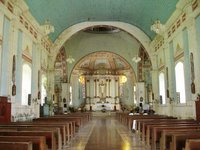 As I left, a funeral procession was about to enter the church and you could hear the play of the church bells. I remember that the tune played by the bells announced to the public a message, that someone was getting married, that it was fiesta time, that a male or female died and there was a requiem Mass, etc. and each had a particular tune.
As I left, a funeral procession was about to enter the church and you could hear the play of the church bells. I remember that the tune played by the bells announced to the public a message, that someone was getting married, that it was fiesta time, that a male or female died and there was a requiem Mass, etc. and each had a particular tune.  From San Jose, I took a bus straight Naga City. It wasn't difficult to board one since they left Lagonoy quite regularly. It costed PHP40. The view along the way was also great since you had Mount Isarog on your right and Mount Iriga (below) on your left. While on the bus, it started to rain which was good since it brought down the temperature.
From San Jose, I took a bus straight Naga City. It wasn't difficult to board one since they left Lagonoy quite regularly. It costed PHP40. The view along the way was also great since you had Mount Isarog on your right and Mount Iriga (below) on your left. While on the bus, it started to rain which was good since it brought down the temperature. I arrived in Naga at about 3:30 p.m. and the first thing I did was to purchase a ticket back to Manila. This time I made sure to purchase the Philtranco Gold Service ticket since their executive buses had airline seats and were more spacious. It costs PHP200 more than the regular aircon bus at PHP800 plus PHP6 for insurance. The bus was going to leave at 9 p.m. so just enough time to explore Naga.
I arrived in Naga at about 3:30 p.m. and the first thing I did was to purchase a ticket back to Manila. This time I made sure to purchase the Philtranco Gold Service ticket since their executive buses had airline seats and were more spacious. It costs PHP200 more than the regular aircon bus at PHP800 plus PHP6 for insurance. The bus was going to leave at 9 p.m. so just enough time to explore Naga. When that was done, I took a tricycle from the terminal to the Naga Cathedral which had a large centuries old seminary building right beside it, the Holy Rosary Seminary. The Naga Cathedral was itself monumental. But inside, you could see that the interior had already been renovated, seemingly by the same group which is planning to make St. Peter's Basilicas out of the other Camarines churches. Indeed, St. Peter's is a work of art but we have our own Filipino church art which we must endeavor to preserve. Let's not try to erase what makes us uniquely Filipino.
When that was done, I took a tricycle from the terminal to the Naga Cathedral which had a large centuries old seminary building right beside it, the Holy Rosary Seminary. The Naga Cathedral was itself monumental. But inside, you could see that the interior had already been renovated, seemingly by the same group which is planning to make St. Peter's Basilicas out of the other Camarines churches. Indeed, St. Peter's is a work of art but we have our own Filipino church art which we must endeavor to preserve. Let's not try to erase what makes us uniquely Filipino.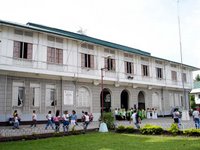 From the Naga Cathedral, I took another tricycle to the Peñafrancia Shrine. But along the way, I chanced upon the Camarines Sur National High School's Gabaldon building and told the driver to drop me off there instead. I had known from old photos that the old Pampanga High School building had a twin in Naga and finally, I found it! It was quite well-preserved so I immediately texted our friends in Pampanga that we now have a basis for the interior of the old PHS when we restore it since the buildings are close to 100% identical.
From the Naga Cathedral, I took another tricycle to the Peñafrancia Shrine. But along the way, I chanced upon the Camarines Sur National High School's Gabaldon building and told the driver to drop me off there instead. I had known from old photos that the old Pampanga High School building had a twin in Naga and finally, I found it! It was quite well-preserved so I immediately texted our friends in Pampanga that we now have a basis for the interior of the old PHS when we restore it since the buildings are close to 100% identical. From there, I walked to the shrine. A wedding has just finished and the floor was full of rose petals. The original image of Our Lady of Penafrancia was no longer there and had been transferred to a bigger church, the Peñafrancia Basilica Minore a few meters away. Except for the finish of the facade, the church and its convent remained mostly untouched. I noticed the gravestones on the floor had been smoothened out, obviously by the large number of devotees visiting the shrine and there was no longer a trace that a name used to be carved on them. Sad!
From there, I walked to the shrine. A wedding has just finished and the floor was full of rose petals. The original image of Our Lady of Penafrancia was no longer there and had been transferred to a bigger church, the Peñafrancia Basilica Minore a few meters away. Except for the finish of the facade, the church and its convent remained mostly untouched. I noticed the gravestones on the floor had been smoothened out, obviously by the large number of devotees visiting the shrine and there was no longer a trace that a name used to be carved on them. Sad!From there, it was off to the Peñafrancia Basilica Minore which was another tricycle ride away. This was the second time I visited the church. There was a restaurant in the compound so I decided to have dinner there.
 I realized that I had forgotten to visit another site, the monument in downtown Naga dedicated to the Fifteen Martyrs of Bicol. So by the time I got there, it was dark. Nevertheless, I was able to take photos of this elegant monument. They don't make monuments like these nowadays.
I realized that I had forgotten to visit another site, the monument in downtown Naga dedicated to the Fifteen Martyrs of Bicol. So by the time I got there, it was dark. Nevertheless, I was able to take photos of this elegant monument. They don't make monuments like these nowadays.It was then back to the station where I decided to wait it out at the airconditioned office of Philtranco. At least I was able to rest. I got on the bus expecting to get a good night's sleep. But I was rudely awakened somewhere in Tagkawayan, Quezon since we were driving along the worst roads I've ever seen with more potholes than craters on the moon. The rough roads and the zigzagging kept me awake for most of the southern Quezon leg. But I was able to sleep better as we neared Manila since the next thing I knew, the driver was waking me up since we were already in Pasay, and I was the only one left on the bus. It reminded me so much of my trip from Vientiane to Bangkok on executive class as well since I was in still in lalaland when we arrived in Bangkok.
Anyway, until the next trip. Do visit my travel photos at http://ivanhenares.multiply.com/photos and my heritage photos at http://photos.yahoo.com/ivanhenares since there are more photos of the sites I described in this entry as well as previous ones.

Hi Ivan,
ReplyDeleteI just love your blog. I really believe you are doing this country a great service, so I hope you keep on doing what you do.
bong
Thanks so much for the wonderful narrative that you wrote about our parish church in a quaint and sleepy town of San Jose, Camarines Sur. It made me home sick yet provided me some comfort that somethings in my life hasn't changed much --and that's comforting.
ReplyDeleteDios mabalos na marhay !
Hi Ivan, is that what we call colonial mentality? The most noble thing they should do is to preserve the place not alter it. Sayang ang pera sa walang katuturang paglustay.
ReplyDeleteIvan,
ReplyDeleteI enjoyed reading your blog, especially the part about Camarines Sur. Thanks for your good words about the church of San Jose, my hometown. Finally, someone is trying to do something about our unique Filipino heritage by preserving the original architectural charm of our churches and not transform them into bad copies of St. Peter's Basilica. Hats off to you and Gemma Cruz-Araneta!
Hi Ivan! Just recently chanced upon your blog.
ReplyDeleteYour explorations in Naga City triggered in this Manila-based Nagueño reminiscings of earliest childhood memories. The Naga Cathedral, I remember as a faint memory now, had dark chandeliers depressingly dangling down its high ceilings back in the 1980s.
Too bad you didn't feature Universidad de Santa Isabel (formerly Colegio de Santa Isabel) which is just accross the street from the cathedral. If I'm not mistaken, it's the second oldest normal school in the country. You could also check out Ateneo de Naga's iconic four pillars.
Well that's Naga, lots of old stuff to discover.
Yes, I saw it but I didn't have enough time to explore since I just had a few hours in Naga. Maybe next time.
ReplyDeleteHi!
ReplyDeleteI chance upon your blog during my search for "kins in spirit". My friends call me a churchopile because of my penchant for Philippine colonial churches. In my travels, I have been to more than 200 of them across the Philippines.
I also had a chance of visiting the Partida church loop (i.e. Sagnay, San Jose, Goa + cluster). These structures of "haunting loveliness" should live forever.
My visitas are posted at http"//bigberto.blogspot.com. Its my own little way of promoting these sacred stones and hopefully, their preservation so they will stay forever.
Mabuhay ka!
shubert
Nice take on Bicol's churches. Sayang, you didn't have time to explore the universities there... CSI or USI (University of Sta. Isabel) is I think oldest normal school in the Philippines. To quote: Founded on November 5, 1867 by Most Rev. Bishop Francisco C. Gainza, O.P. , then Bishop of Caceres, the school was opened to paying and non-paying students as the Royal Order specified. A Royal Decree signed on January 11, 1872, by Amadeo of Saboya, raised the Colegio de Sta. Isabel to "Escuela Normal de Maestras", thus making CSI the first teacher training institution in the Philippines and in the Far East.
ReplyDeletehttp://www.usi.edu.ph/History.php
And of course, Ateneo de Naga... Hope you get to drop by the town again :)
Cheers, Mate (daughter of an Isabelina and an Atenista)
cannot say enough about your blog!! it's refreshing!
ReplyDeleteMabuhay!
hello ivan
ReplyDeleteim going w some friends to albay and follow some of your really nice travelogues.
was just wondering if you have any idea on the state of the andaya highway from calauag quezon to del gallego, cam sur. i plan to bypass cam norte to save us some time.
ive read from posts that the road condition is bad - any new info ? thank you very much
The next time you do a visit-blog on Naga, I hope you'll be able to include Our Lady of Mt. Carmel and the San Francisco Church in Centro. You were already at the Naga Cathedral, and you need not have taken trikes to go around because in Centro, everything is walking distance.
ReplyDeleteMaybe you should also see visit in September or on Holy Week to really get a feel of the Traslacion and the Salubong (which almost all parish churches practice yearly). Also, who was the Parish Priest in Tigaon that you "reasoned" with?